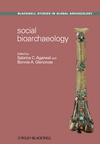In Greek mythology, the Hydra was a dangerous water serpent with many heads. Its breath was allegedly poisonous, and for every head you cut off two more would grow in its place. In the last two weeks, three separate couples on Facebook in my network, who don't know each other, have merged their profiles—they've become Hydras in their own way: a single entity, posting under a hybrid name, generating all sorts of confusion as to who is really behind the content (though language is sometimes a giveaway). Networks emphasize the individual's connection to the collective. What are the implications of these dual identity profiles to the larger social group?
Wednesday, April 27, 2011
Monday, April 25, 2011
Friday, April 22, 2011
Selling the Illusion of Wealth
To round out AiP's discussion on our relationship with fashion, today we're looking at the counterfeit industry. On Monday, we probed the appeal of high-heels. And on Wednesday, we discussed a particular color trend in New York City.
Wednesday, April 20, 2011
Reflections of Gotham: Why Do New Yorkers Wear So Much Black?
This week AiP investigates our relationship with fashion. On Monday, we probed the appeal of high-heels. Today, we’ll discuss a particular color trend in New York City. And on Friday, we’ll explore the psychology behind brands.
Monday, April 18, 2011
Power, Confidence, and High-Heels
This week AiP investigates our relationship with fashion. Today, we’ll delve into the appeal of high-heels. On Wednesday, we’ll discuss a particular color trend in New York City. And on Friday, we’ll explore the psychology behind brands.
Monday, April 11, 2011
On My Shelf: Social Bioarchaeology
At a moment when tensions within anthropology are still simmering close to the surface, Sabrina Agarwal's and Bonnie Glencross' edited collection of social bioarchaeological essays highlight the importance of collaborative efforts within the discipline. The volume is definitely not light reading, however, it represents a carefully curated exhibit on the development of biological archaeology and traces its relevance to current research.
Subscribe to:
Posts (Atom)






